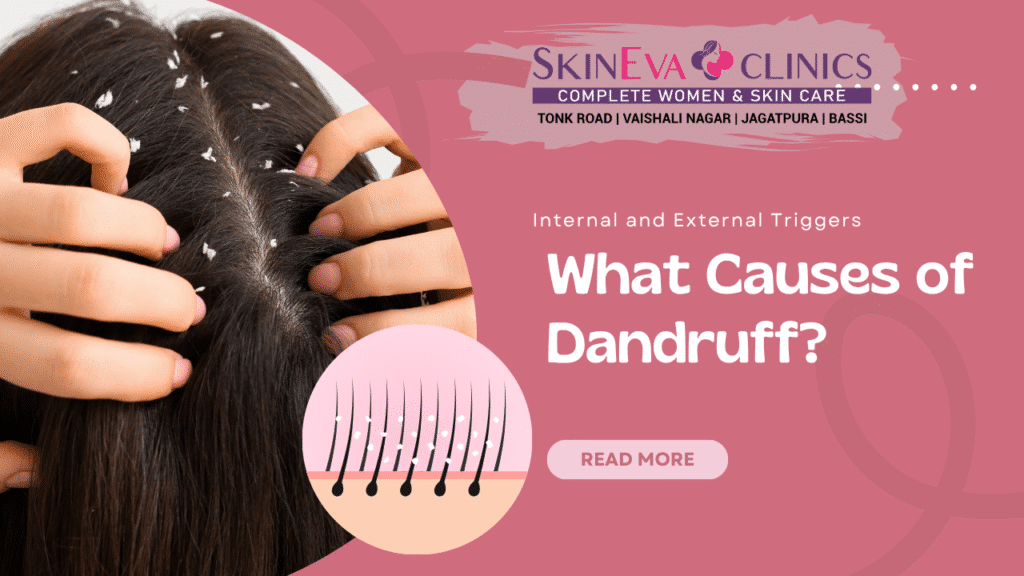What Causes of Dandruff? Internal and External Triggers

Introduction:
Dandruff is one of the most frequently encountered scalp issues that can affect anyone regardless of age or hair type. It is often associated with visible flakes, scalp irritation, and persistent itching, making it not just a cosmetic concern but also a source of discomfort and embarrassment for many individuals. Whether it’s those tiny white specks on your shoulders or the constant need to scratch your scalp, dandruff can interfere with your confidence and daily routine.
Despite being common, dandruff is often misunderstood. Some people assume it’s simply due to poor hygiene, while others believe it’s only a result of dry skin.
Before we explore what triggers dandruff, it’s essential to clearly understand what dandruff actually is.
What is Dandruff?
Dandruff is a non-contagious scalp condition marked by the excessive shedding of dead skin cells from the scalp. Under normal conditions, your scalp continuously renews itself, and old skin cells fall off in tiny, unnoticeable amounts. However, when this process speeds up or becomes imbalanced, the skin cells begin to clump together and shed in the form of visible flakes. These flakes can be white or yellowish and are often accompanied by itchiness, irritation, or redness on the scalp.
Dandruff can present differently depending on the type of scalp you have. People with dry scalps often notice light, powdery flakes that fall off easily. On the other hand, those with oily scalps may experience sticky, greasy flakes that cling to the scalp and hair shafts. In some cases, the condition may progress into more severe forms like seborrheic dermatitis, which involves inflammation and redness along with scaling.
Understanding the root cause is key to treating and controlling dandruff successfully.
Causes of Dandruff: Why Does Your Scalp Flake?
Dandruff is one of the most common scalp concerns, but its root causes are not always the same for everyone. Some people experience it due to internal factors like hormones or skin disorders, while others might get it from external issues like product buildup or poor hygiene.
Effective dandruff control begins with identifying what triggers it in your scalp. Let’s break down the major internal and external causes behind this flaky, itchy condition.
Internal Causes of Dandruff
These internal elements interfere with your scalp’s natural environment and balance.
1. Overgrowth of Malassezia (Scalp Fungus)
Malassezia is a yeast-like fungus that normally lives on a healthy scalp. It feeds on natural oils (sebum) secreted by your scalp. However, when there is too much oil or an imbalance in scalp conditions, Malassezia can grow excessively.
This overgrowth irritates the scalp and speeds up the shedding of skin cells. These dead skin cells mix with oil and form the white or yellowish flakes commonly seen in dandruff.
2. Seborrheic Dermatitis
This is a chronic inflammatory skin condition and a more severe form of dandruff. It causes greasy, red, itchy patches covered with thick, flaky scales on the scalp and sometimes other oily areas like the face or chest.
Seborrheic dermatitis is linked to an overactive immune response to Malassezia and is often seen in people with oily skin.
3. Hormonal Changes
Hormone shifts from puberty, menstruation, or PCOS may raise scalp oil levels, worsening dandruff. This extra oil can feed Malassezia or clog the scalp, creating a perfect condition for dandruff to develop.
4. Genetics (Family History)
Some individuals inherit a tendency to produce more oil or have more sensitive skin. A family history of dandruff or seborrheic dermatitis increases your risk of experiencing it too.
5. Skin Conditions (Eczema, Psoriasis)
Certain skin conditions that affect other parts of your body can also affect your scalp.
- Eczema leads to dry, irritated skin and can cause fine flakes and itching.
- Psoriasis causes thick, silvery-white patches that can peel off, resembling dandruff.
These conditions often require medical treatment rather than just anti-dandruff shampoos.
6. Nutritional Deficiencies
Lack of key nutrients—especially vitamins B2, B3, B6, B7 (biotin), vitamin D, zinc, and omega-3 fatty acids—can weaken your scalp’s natural barrier. This increases the risk of dryness, irritation, and dandruff formation.
7. Stress and Immunity
Stress doesn’t directly cause dandruff, but it weakens your immune system, making your body more reactive to triggers like Malassezia or allergens. It can also worsen existing skin conditions, including seborrheic dermatitis.
External Causes of Dandruff
These causes are related to your surroundings, hair care habits, or lifestyle choices.
1. Dry Scalp from Weather or Styling
In colder months or dry environments, your scalp can lose moisture quickly. This leads to tightness, flaking, and irritation. Overuse of heat styling tools like blow dryers, or hot water showers, can also strip away natural oils, resulting in dryness and dandruff-like symptoms.
2. Excess Oil and Sebum Production
Contrary to dry scalp, some people experience dandruff due to an oily scalp. When too much oil builds up, it can mix with dead skin cells and form sticky flakes. It also promotes the growth of Malassezia, increasing inflammation and scaling.
3. Improper Scalp Hygiene
Not washing your hair often enough or rinsing poorly can cause oil, dirt, sweat, and product residue to accumulate. This creates a breeding ground for bacteria and fungi, leading to itchy, flaky scalp conditions.
4. Sensitivity to Hair Care Products (Contact Dermatitis)
Some shampoos, conditioners, gels, or serums contain harsh chemicals, fragrances, or preservatives. These ingredients can irritate sensitive scalps and trigger inflammation, redness, and flaking. This allergic reaction is called contact dermatitis, and it can mimic or worsen dandruff.
5. Too Frequent or Infrequent Shampooing
Both extremes can be harmful:
- Washing too little causes oil and dead skin buildup.
- Washing too often can strip natural oils, drying out your scalp. Striking the right balance is crucial to maintain a healthy scalp.
6. Tight Hats or Headgear
Wearing helmets, scarves, or hats for long periods can trap heat, sweat, and oil, creating a moist environment that encourages fungal growth and leads to scalp irritation and flakes.
7. Pollution, Dust, and UV Exposure
Environmental stressors like dirt, smoke, and excessive sun exposure can damage the scalp’s protective layer. Dust and pollution clog hair follicles, while UV damage dries out the scalp, both contributing to dandruff symptoms.
8. Diet High in Sugar and Processed Foods
Eating too many sugary or processed foods may fuel inflammation, contributing to scalp problems. Such diets may also worsen fungal imbalances on the scalp, allowing Malassezia to thrive.
Conclusion
Dandruff is not just a cosmetic issue—it’s a sign that something might be off, either inside your body or in your hair care routine. By understanding whether your dandruff is caused by internal imbalances like hormones, yeast, or skin conditions—or external factors like pollution, styling habits, or product reactions—you can target the root cause and treat it effectively.



Leave a Comment